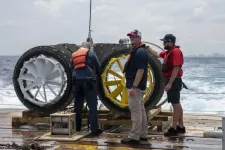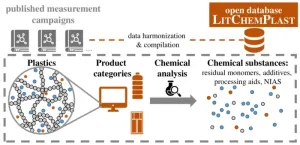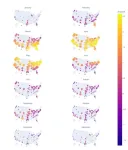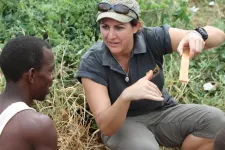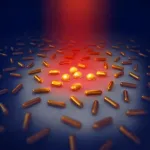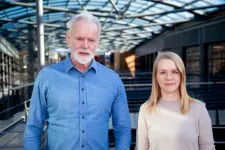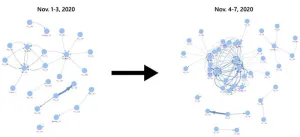(Press-News.org) An international coalition of researchers from the United States and Italy has discovered a novel strain of cyanobacteria, or algae, isolated from volcanic ocean vents that is especially adept at growing rapidly in the presence of CO2 and readily sinks in water, making it a prime candidate for biologically-based carbon sequestration projects and bioproduction of valuable commodities. This strain, nicknamed “Chonkus,” was found off the coast of the island of Vulcano in Sicily, Italy — an environment in which marine CO2 is abundant due to shallow volcanic vents. The discovery is described in a paper published today in Applied Environmental Microbiology.
“Dissolved carbon is relatively dilute compared to all the other molecules in the ocean, and that limits the growth of photosynthetic organisms that live there. We decided to investigate what happens when you alleviate that limiting factor by going to a place with plenty of carbon, where some organisms could have evolved the ability to use it to galvanize their growth,” said co-corresponding author Max Schubert, Ph.D., who was a staff scientist at the Wyss Institute at Harvard University when the work was conducted and is now Lead Project Scientist at Align to Innovate. “This naturally occurring strain of cyanobacteria has several traits that could be useful to humans, including highly dense growth and a natural tendency to sink in water, making Chonkus a particularly interesting organism for future work on decarbonization and biomanufacturing.”
From the shallow sea to the lab bench
Schubert and fellow corresponding author Braden Tierney, Ph.D. first met as bench neighbors in the lab of Wyss Core Faculty member George Church, Ph.D. nine years ago, but didn’t start collaborating until both were later working at Harvard Medical School (HMS) in 2016. Schubert, a microbiologist who was interested in building tools for directed evolution of bacteria and their genomes, submitted a proposal to the HMS Consortium for Space Genetics’ 2019 Symposium on Climate Change to bring this work to cyanobacteria. He won the top prize, which funded his early forays into applying his tools to cyanobacteria to investigate their potential to help fix and sequester carbon.
Meanwhile, Tierney, who was then a postdoc co-advised by Schubert’s advisor Church, was sent a paper by a friend about shallow seeps - areas on the ocean floor where gasses seep into the water but are shallow enough to receive sunlight - and realized that there might be photosynthetic microbes living in those environments that had evolved to be adept at capturing dissolved CO2 from the water. He made connections with Marco Milazzo, Ph.D. and Paola Quatrini, Ph.D., both professors at the University of Palermo in Sicily, who were actively studying nearby, accessible shallow seeps. Tierney secured funding for a collecting expedition from SeedLabs, and reached out to Schubert for help understanding and working with the cyanobacteria that could be present in that environment.
Tierney and Schubert assembled a coalition that ultimately included scientists from the Wyss Institute, HMS, Weill Cornell Medical College, Colorado State University, University of Wisconsin-Madison, MIT, the National Renewable Energy Laboratory in Colorado, and multiple institutions in Palermo, Italy. The group launched a field expedition to the ocean off the coast of Vulcano where they donned SCUBA suits and collected water samples from a CO2-rich shallow seep. They then shipped tubes of the seawater across the Atlantic to Boston, where scientists led by Schubert isolated and characterized the microbes living in the samples.
One microbe’s bug is a feature for humanity
To coax their target cyanobacteria to grow, the researchers replicated the conditions a fast-growing cyanobacteria would thrive in: warm temperatures, lots of light, and plenty of CO2. After isolation from enrichment cultures, two strains of fast-growing cyanobacteria were discovered: UTEX 3221 and UTEX 3222. The team chose to focus on UTEX 3222 due to its single-celled growth, which made it easier to compare to existing cyanobacteria strains.
UTEX 3222 produced larger colonies than other known fast-growing cyanobacteria strains, and its individual cells were larger as well – thus the moniker Chonkus. It also grew to higher density than existing strains, appeared to harbor carbon-containing storage granules in its cells, and had a higher overall carbon content than other strains: all potentially valuable traits for applications like carbon sequestration and bioproduction. Most interestingly, Chonkus rapidly settled into a dense pellet resembling “green peanut butter” at the bottom of its sample tubes, while other strains remained suspended. This behavior is especially valuable for industrial processing, as concentrating and drying biomass currently accounts for 15-30% of production costs.
“Many of the traits that we observed in Chonkus aren’t inherently useful in their natural environment, but are very useful to humans. Aquatic organisms naturally grow at very low density, but being able to grow to a high density at higher temperatures is very helpful in the industrial environments that we use to manufacture many goods and products, and can help sequester more carbon,” said Tierney. “An incredible amount of microbial diversity exists out there in the world, and we believe it’s more efficient to seek out the microbes that have already evolved to succeed in human-relevant environments rather than trying to engineer all of the traits we want into lab-grown E. coli bacteria.”
The team is excited about the many applications that could be addressed with Chonkus or modified versions of the microbe. Many organizations are investigating the use of fast-growing organisms for carbon sequestration, and Chonkus could one day join their ranks. Several products are currently manufactured in algae, like omega-3 fatty acids, the antioxidant astaxanthin, and spirulina, and could be made more efficiently in a strain that grows quickly and densely. And the fact that cyanobacteria directly harvest carbon from their environment to grow means that they can couple the processes of carbon sequestration and biomanufacturing together in a single organism. Samples of UTEX 3222 and UTEX 3221 are cryopreserved and publicly available for other researchers to use from the Culture Collection of Algae at the University of Texas, Austin.
Inspired by the success of their first expedition, Tierney has since co-founded a non-profit organization with paper co-authors Krista Ryon and James Henriksen called The Two Frontiers Project, which aims to study how life thrives in extreme environments through next-generation scientific expeditions. The group has already completed subsequent expeditions to hot springs in Colorado, the Smoking Lands in the Tyrrhenian Sea, the coral reefs of the Red Sea, and others. The organization is focused on microbes that have uses for three major applications: carbon capture, CO2 upcycling for sustainable products, and coral ecosystem restoration.
“The traits inherent in the naturally evolved cyanobacteria strains described in this research have the potential to be used both in industry and the environment, including biomanufacturing of useful carbon-based products or sinking large volumes of carbon to the ocean floor. While further modifications could be made to enhance these microbes’ abilities, harnessing billions of years of evolution is a significant leg up in humanity’s urgent need to mitigate and reverse climate change,” said Church, who is also the Robert Winthrop Professor of Genetics at HMS and a Professor of Health Sciences and Technology at Harvard and MIT. “But it’s very important to ‘build the seatbelts before you build the car’ – our lab also studies bio-containment approaches that help contain and control these kinds of experiments.”
“The Wyss Institute was founded on the belief that Nature is the best source of innovation on the planet, and that emulating its principles is the key to driving positive impact. I’m proud of this team for getting out of the lab and seeking Nature’s best ideas where they’ve already developed. This is a wonderful example of how our new Sustainable Futures Initiative is pursuing out-of-the-box approaches to confront climate change - the biggest challenge of our generation,” said Wyss Founding Director Don Ingber, M.D., Ph.D., who is also the Judah Folkman Professor of Vascular Biology at HMS and Boston Children’s Hospital and the Hansjörg Wyss Professor of Biologically Inspired Engineering at Harvard’s John A. Paulson School of Engineering and Applied Sciences.
Additional authors of the paper include Tzu-Chieh Tang, Isabella Goodchild-Michelman, Krista Ryon, James Henriksen, Theodore Chavkin, Yanqi Wu, Teemu Miettinen, Stefanie Van Wychen, Lukas Dahlin, Davide Spatafora, Gabriele Turco, Michael Guarnieri, Scott Manalis, John Kowitz, Raja Dhir, Paola Quatrini, Christopher Mason, and Marco Milazzo.
This research was supported by the US Department of Energy (DOE) under grant no. DE-FG02-02ER63445 and by the National Science Foundation (NSF) award no. MCB-2037995, SEED Labs, the WorldQuant Foundation, the Scientific Computing Unit (SCU) at Weill Cornell Medical College, and the International CO2 Natural Analogues (ICONA) Network.
END
Newly discovered cyanobacteria could help sequester carbon from oceans and factories
Strains specialized to live in high-CO2 oceanic environments have evolved traits that are useful for decarbonization and bioproduction
2024-10-29
ELSE PRESS RELEASES FROM THIS DATE:
Making scents of aromas that differentiate beer and wine
2024-10-29
Today, people increasingly seek non-alcoholic versions of beer or wine. Despite boasting different flavors, these two drinks share many aromas, which makes it difficult to produce alcohol-free versions that mimic the real thing. Researchers in ACS’ Journal of Agricultural and Food Chemistry report on a literature analysis and experiment to characterize the chemical compounds that give beer and wine their unique fragrances. They say their findings could aid the development of flavorful, non-alcoholic substitutes.
Food and beverage researchers are working to recreate the enjoyable aromas and flavors of beer and wine in alcohol-free substitutes. However, because both beer and ...
FAU awarded DOE grant to test ocean current energy offshore Palm Beach County
2024-10-29
Imagine harnessing the power of ocean currents to generate clean, renewable energy right off the coast of Southeast Florida. Florida Atlantic University’s Southeast National Marine Renewable Energy Center (SNMREC) has been awarded an $800,000 grant from the United States Department of Energy’s Water Power Technologies Office to enable the commercial readiness of ocean energy technologies.
SNMREC, in collaboration with a team of experts including The City of Lake Worth Beach Electric Utility, 3U Technologies, 48 North Solutions, IDOM Incorporated, Braid Theory, and the European Marine Energy Centre (EMEC), ...
Open-access database compiles 3,500 substances measured in plastic products: Study highlights substantial knowledge gaps
2024-10-29
About this study: Plastics contain a vast number of chemicals, some of which greatly impact the environment and human health. However, information on the presence of individual substances in plastic products is oftentimes not publicly available. In a peer-reviewed study, set to be published on 29 October 2024, in Environmental Science and Technology Letters, a new publicly accessible database on chemicals measured in plastics is presented - LitChemPlast. The database contains over 3’500 substances measured in over 47'000 samples of plastic products across 372 studies.
Key findings:
• Contamination of recycled plastics:
The database shows that, due to ...
Internet activity reveals national allergy patterns
2024-10-29
Complaining about your allergies online might provide valuable data to researchers. Over 25% of Americans experience seasonal allergies, but how the prevalence of seasonal allergies varies across space and time remains obscure, in part because allergies seldom warrant visits to healthcare providers. Elias Stallard-Olivera and Noah Fierer mined Twitter (now X) posts and Google searches from 2016–2020 to extrapolate spatial and temporal allergy patterns. A natural language processing model sorted posts that indicated symptoms (e.g., “My allergies are really bad today!!”) from posts that include key words but did not indicate the presence of symptoms (e.g., “Gluten ...
New study confirms beehive fences as highly effective in reducing human-elephant conflict, but researchers warn of future risks
2024-10-29
[11:00 GMT - 29 Oct 2024] A groundbreaking, nine-year study has revealed that elephants approaching small-scale farms in Kenya avoid beehive fences housing live honey bees up to 86% of the time during peak crop seasons, helping to reduce human-elephant conflict for local farmers and boost income. Link to images and video of the project available
Key findings include:
Beehive fences are a proven success in reducing human-elephant conflict in Africa.
Savannah elephants avoid beehive fences housing live honey bees up to 86% of the time during peak crop seasons.
Across all seasons and the entire study period, the fences deterred an annual average of 76% of 3,999 ...
Tiny gold radiators fry bacteria on implants
2024-10-29
In the fight against antibiotic resistance, a new technology developed at Chalmers University of Technology, in Sweden, can be of great importance when, for example, hip and knee implants are surgically inserted. By heating up small nanorods of gold with near-infrared light (NIR), the bacteria are killed, and the surface of the implant becomes sterile. The researchers are now presenting a new study that increases the understanding of how the gold rods are affected by light and how the temperature in them can be measured.
Infections can occur during surgical procedures, with the risk increasing significantly when foreign materials, ...
WISH announces shortlist for Global Healthcare Innovation Awards
2024-10-29
29 October 2024. Doha, Qatar – The World Innovation Summit for Health (WISH), an initiative of Qatar Foundation, has shortlisted 12 innovators for two awards within the 2024 WISH Global Healthcare Innovation Competition. Selected from more than 150 applications, the 12 will showcase their groundbreaking innovations to global policymakers and healthcare leaders at this year’s summit in Doha, 13-14 November.
In addition to the chance to receive one of two investment awards of US$10,000, shortlisted innovators will have access to mentoring sessions with industry experts to learn ...
Discovery of cancer risk associations for six novel genes
2024-10-29
Discovery of cancer risk associations for six novel genes
Scientists at deCODE genetics/Amgen, and their collaborators have discovered six novel genes with rare germline variants that associate with cancer risk. The findings are published today in Nature Genetics under the title “Gene-based burden tests of rare germline variants identify six cancer susceptibility genes”.
A subset of cancers arises in individuals who are born with rare sequence variants that significantly alter their cancer risk. The discovery of such variants, like those in the BRCA1- and BRCA2 genes, has led to improved early cancer detection ...
More than half of European heat-related deaths in summer 2022 attributed to anthropogenic warming
2024-10-29
The unprecedented temperatures in the summer of 2022 caused more than 68,000 deaths on the continent, according to a study by the Barcelona Institute for Global Health (ISGlobal), a centre supported by the 'la Caixa' Foundation. A new study has now found that more than half - 56% - of the heat-related deaths in the summer of 2022 were related to human-induced climate change. According to the research, 38,154 of the 68,593 heat-related deaths in the summer of 2022 would not have occurred without anthropogenic warming.
The ...
Major events like presidential elections bring online hate communities together
2024-10-29
WASHINGTON (October 29, 2024) – A new study published today details the ways in which the 2020 U.S. election not only incited new hate content in online communities but also how it brought those communities closer together around online hate speech. The research has wider implications for better understanding how the online hate universe multiplies and hardens around local and national events such as elections, and how smaller, less regulated platforms like Telegram play a key role in that universe by creating and sustaining hate content.
The study – published in the journal npj Complexity, part of the Nature portfolio of journals – ...
LAST 30 PRESS RELEASES:
AI overestimates how smart people are, according to HSE economists
HSE researchers create genome-wide map of quadruplexes
Scientists boost cell "powerhouses" to burn more calories
Automatic label checking: The missing step in making reliable medical AI
Low daily alcohol intake linked to 50% heightened mouth cancer risk in India
American Meteorological Society announces Rick Spinrad as 2026 President-Elect
Biomass-based carbon capture spotlighted in newly released global climate webinar recording
Illuminating invisible nano pollutants: advanced bioimaging tracks the full journey of emerging nanoscale contaminants in living systems
How does age affect recovery from spinal cord injury?
Novel AI tool offers prognosis for patients with head and neck cancer
Fathers’ microplastic exposure tied to their children’s metabolic problems
Research validates laboratory model for studying high-grade serous ovarian cancer
SIR 2026 delivers transformative breakthroughs in minimally invasive medicine to improve patient care
Stem Cell Reports most downloaded papers of 2025 highlight the breadth and impact of stem cell research
Oxford-led study estimates NHS spends around 3% of its primary and secondary care budget on the health impacts of heat and cold in England
A researcher’s long quest leads to a smart composite breakthrough
Urban wild bees act as “microbial sensors” of city health.
New study finds where you live affects recovery after a hip fracture
Forecasting the impact of fully automated vehicle adoption on US road traffic injuries
Alcohol-related hospitalizations from 2016 to 2022
Semaglutide and hospitalizations in patients with obesity and established cardiovascular disease
Researchers ‘listen in’ to embryo-mother interactions during implantation using a culture system replicating the womb lining
How changing your diet could help save the world
How to make AI truly scalable and reliable for real-time traffic assignment?
Beyond fragmented markets: A new framework for efficient and stable ride-pooling
Can shape priors make road perception more reliable for autonomous driving?
AI tracks nearly 100 years of aging research, revealing key trends and gaps
Innovative techniques enable Italy’s first imaging of individual trapped atoms
KIER successfully develops Korea-made “calibration thermoelectric module” for measuring thermoelectric device performance
Diversifying US Midwest farming for stability and resilience
[Press-News.org] Newly discovered cyanobacteria could help sequester carbon from oceans and factoriesStrains specialized to live in high-CO2 oceanic environments have evolved traits that are useful for decarbonization and bioproduction
